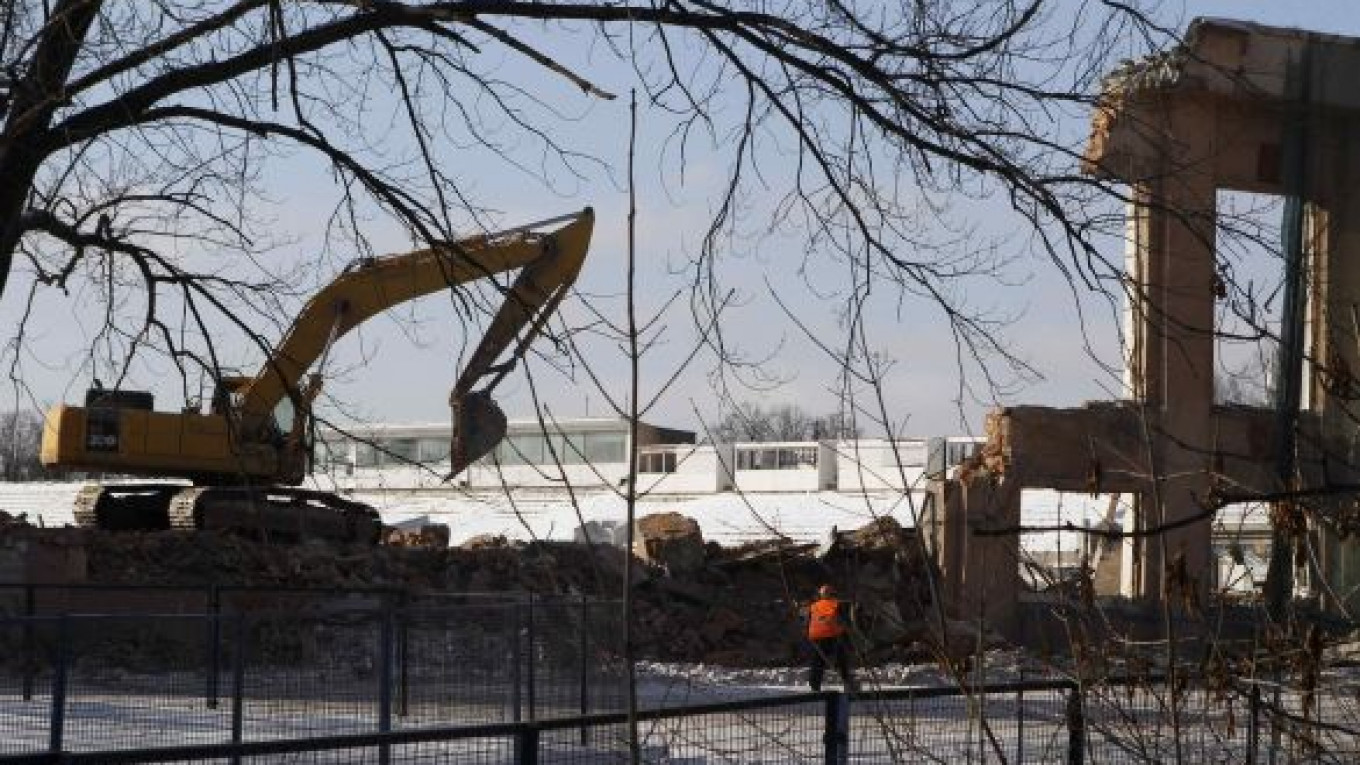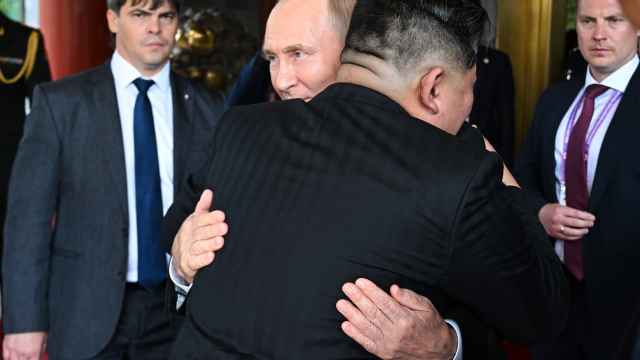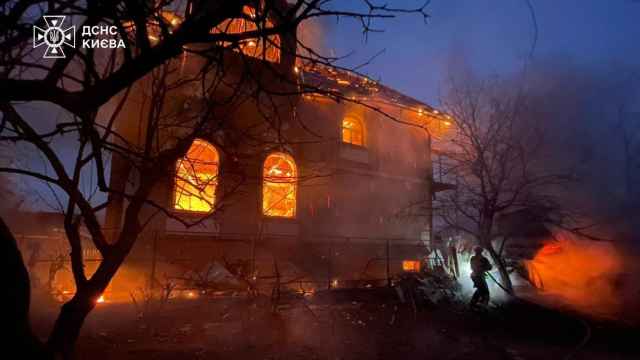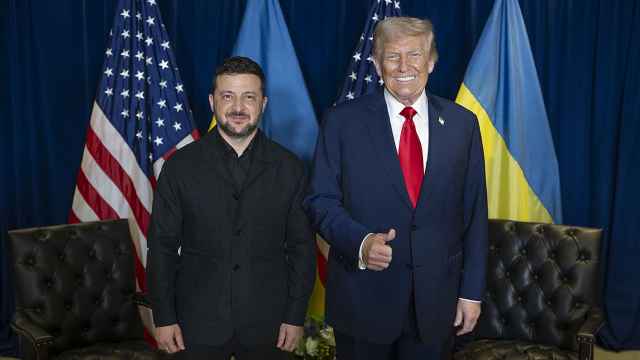Architectural preservation group Arkhnadzor said Monday that demolition at the constructivist-era Dynamo football stadium as a part of ongoing building work was against the law.
The iconic sports venue controlled by state-owned banking giant VTB is undergoing a $1.5 billion redevelopment that will see it become one of the landmark sites for the 2018 Football World Cup.
But activists said contractors employed by VTB-Arena Park, the company in charge of the project, began tearing down the exterior walls of Dynamo's stadium on Friday in violation of its listed status.
"What is going on now is absolutely illegal," said Natalya Samover, an Arkhnadzor activist.
Removing the outer walls of the stadium, which was built in 1928, would also contravene the official architectural design by star Dutch architect Erik van Egeraat and Russian heavyweight Mikhail Posokhin. A jury picked by former Moscow Mayor Yury Luzhkov chose their proposal as the winner of a competition to renovate the site in 2010.
"I am not able to verify what is going on," van Egeraat said by phone from the Netherlands on Monday. "It is not necessary to demolish the walls."
He said his design had been made with the explicit intention to preserve the outer walls and that he was "shocked" to hear they might have been destroyed.
Under the long-discussed redevelopment, an enormous glass structure in the shape of a donut — or, according to its detractors, a toilet bowl — will be suspended above the old walls to create a 45,000-seat stadium that fuses the old and the new.
The site was visited on Feb. 2 by Mayor Sergei Sobyanin, VTB head Andrei Kostin and the director of VTB-Arena Park Andrei Peregudov. During the trip, Peregudov said "the preservation of the historical form of the site is a point of principle."
The press service of VTB-Arena Park said Monday that only one-quarter of the stadium's outer facade was fully protected. "The walls from 1928 are only to be found on the western stands," the company said, "everywhere else there is nothing to protect because it's all from the 1980s."
Dynamo's stadium underwent significant building work ahead of the 1980 Olympic Games hosted in Moscow.
The eastern, northern and southern stands will be demolished and then rebuilt, VTB-Arena Park said. "It will be the same view, they will look just like they looked in 1928, but they will be reconstructed from new materials," a spokesperson told The Moscow Times.
The company added that it always worked strictly in accordance with the law and was committed to making a "living stadium."
But preservationists accused the company of half-truths. "It's very disingenuous to say they are knocking down a 1980s building," said Clementine Cecil, co-founder of the Moscow Architectural Preservation Society.
Arkhnadzor highlighted the plight of what they said were 1930s bas-reliefs created by Soviet sculptor Sergei Merkurov on the parts due to be destroyed.
It was also inaccurate to suggest that the majority of the original 1928 structure was flattened prior to the Olympic Games, activist Samover added. "Nobody pulled down three-quarters of the stadium," she said.
Arkhnadzor conducted a rotating one-man picket on Turgenevskaya Ploshchad on Monday to protest the demolition work.
The side played its last match at the stadium before it was closed for redevelopment in 2008. VTB took over cash-strapped Dynamo Football Club in 2009 after it failed to meet its debt obligations during the financial crisis. The redevelopment of the entire site is expected to be completed by 2016 and include other sporting venues, a luxury hotel and car-parking facilities.
The current renovation work was made possible by a change in the stadium's heritage status in July 2011 to that of a "notable place," according to materials distributed by VTB-Arena Park.
An application to redesignate another famous Soviet landmark in Moscow — the All-Russia Exhibition Center — to that of a "notable place" ahead of its controversial $1.5 billion makeover is expected to be completed later this year.
Dynamo stadium, which has a statue of goalkeeper Lev Yashin at is entrance, was officially registered as a listed building — a "monument of architecture" in 1987. It was designed by constructivist architects Leonid Cherikover and Alexander Langman and built between 1927 and 1936.
Activist Cecil said it is much harder to rally support for the preservation of some buildings than others. "A lot of people don't really care about the Dynamo [stadium]," she said.
"As fans we do not understand some of the initiatives of Arkhnadzor," Alexei Pimonov, head of Dynamo's official fan club, told The Moscow Times. Pimonov, who attended his first match at Dynamo in 1989, pointed out that the stadium had deteriorated dangerously prior to its closure and that there were never any toilets for female supporters.
"It's better to live in a new house," he said.
A Message from The Moscow Times:
Dear readers,
We are facing unprecedented challenges. Russia's Prosecutor General's Office has designated The Moscow Times as an "undesirable" organization, criminalizing our work and putting our staff at risk of prosecution. This follows our earlier unjust labeling as a "foreign agent."
These actions are direct attempts to silence independent journalism in Russia. The authorities claim our work "discredits the decisions of the Russian leadership." We see things differently: we strive to provide accurate, unbiased reporting on Russia.
We, the journalists of The Moscow Times, refuse to be silenced. But to continue our work, we need your help.
Your support, no matter how small, makes a world of difference. If you can, please support us monthly starting from just $2. It's quick to set up, and every contribution makes a significant impact.
By supporting The Moscow Times, you're defending open, independent journalism in the face of repression. Thank you for standing with us.
Remind me later.







